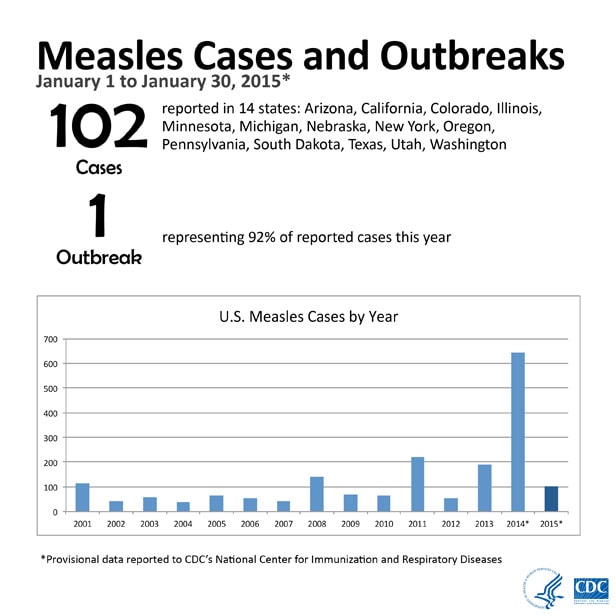Measles
The CDC has a great graphic with simply stated bullets related to the recent measles outbreak:

These are irrefutable facts. The world is a safer place when people get vaccinated. Public health is endangered when pockets of the population opt out of vaccinations. Here's an article by someone more educated on the topic who makes a great synopsis of the issue ("breathtaking science denialism" struck a chord with me):
http://www.forbes.com/sites/stevensalzberg/2015/02/01/anti-vaccine-movement-causes-worst-measles-epidemic-in-20-years/
A year ago I blogged about Whooping Cough. This year it's Measles. What will be next? While the scientific community struggles to fend off HIV, ebola, malaria, and other infectious diseases, we
should pause to reflect on the value of developments in a world where communities can willingly permit diseases to persist. The annual struggle to vaccinate the population against the flu is a microcosm for the state of other vaccinations. In heavy flu seasons, with plenty of sickness, people are more likely to remember that and get vaccinated the next season. When the flu vaccine works especially well and there is a lighter flu outbreak, people are less likely to get vaccinated. This ironic outcome is a product of the fleeting state of human memory, but the impact of a flu outbreak pales in comparison to diseases most schools require students to be inoculated from. According to the World Health Organization (WHO), there were 145,700 deaths caused by measles in 2013 and prior to worldwide vaccination efforts there were approximately 2.6 million deaths caused by measles prior to 1980. Whether the chance of death is 0.1% or 10%, there's no good reason to accept 0% prevention from something that still kills thousands every year. For the people with compromised immune systems that cannot get vaccinated, there's no excuse possible from those who can fully benefit from the vaccines but intentionally choose not to do so.

- The majority of the people who got measles were unvaccinated.
- Measles is still common in many parts of the world including some countries in Europe, Asia, the Pacific, and Africa.
- Travelers with measles continue to bring the disease into the U.S.
- Measles can spread when it reaches a community in the U.S. where groups of people are unvaccinated.
These are irrefutable facts. The world is a safer place when people get vaccinated. Public health is endangered when pockets of the population opt out of vaccinations. Here's an article by someone more educated on the topic who makes a great synopsis of the issue ("breathtaking science denialism" struck a chord with me):
http://www.forbes.com/sites/stevensalzberg/2015/02/01/anti-vaccine-movement-causes-worst-measles-epidemic-in-20-years/
A year ago I blogged about Whooping Cough. This year it's Measles. What will be next? While the scientific community struggles to fend off HIV, ebola, malaria, and other infectious diseases, we
should pause to reflect on the value of developments in a world where communities can willingly permit diseases to persist. The annual struggle to vaccinate the population against the flu is a microcosm for the state of other vaccinations. In heavy flu seasons, with plenty of sickness, people are more likely to remember that and get vaccinated the next season. When the flu vaccine works especially well and there is a lighter flu outbreak, people are less likely to get vaccinated. This ironic outcome is a product of the fleeting state of human memory, but the impact of a flu outbreak pales in comparison to diseases most schools require students to be inoculated from. According to the World Health Organization (WHO), there were 145,700 deaths caused by measles in 2013 and prior to worldwide vaccination efforts there were approximately 2.6 million deaths caused by measles prior to 1980. Whether the chance of death is 0.1% or 10%, there's no good reason to accept 0% prevention from something that still kills thousands every year. For the people with compromised immune systems that cannot get vaccinated, there's no excuse possible from those who can fully benefit from the vaccines but intentionally choose not to do so.

0 Comments:
Post a Comment
<< Home